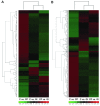Microarray and proteomic analysis of the cardioprotective effects of cold blood cardioplegia in the mature and aged male and female
- PMID: 22968637
- PMCID: PMC3524770
- DOI: 10.1152/physiolgenomics.00011.2012
Microarray and proteomic analysis of the cardioprotective effects of cold blood cardioplegia in the mature and aged male and female
Abstract
Recently we have shown that the cardioprotection afforded by cardioplegia is modulated by age and gender and is significantly decreased in the aged female. In this report we use microarray and proteomic analyses to identify transcriptomic and proteomic alterations affecting cardioprotection using cold blood cardioplegia in the mature and aged male and female heart. Mature and aged male and female New Zealand White rabbits were used for in situ blood perfused cardiopulmonary bypass. Control hearts received 30 min sham ischemia and 120 min sham reperfusion. Global ischemia (GI) hearts received 30 min of GI achieved by cross-clamping of the aorta. Cardioplegia (CP) hearts received cold blood cardioplegia prior to GI. Following 30 min of GI the hearts were reperfused for 120 min and then used for RNA and protein isolation. Microarray and proteomic analyses were performed. Functional enrichment analysis showed that mitochondrial dysfunction, oxidative phosphorylation and calcium signaling pathways were significantly enriched in all experimental groups. Glycolysis/gluconeogenesis and the pentose phosphate pathway were significantly changed in the aged male only (P < 0.05), while glyoxylate/dicarboxylate metabolism was significant in the aged female only (P < 0.05). Our data show that specific pathways associated with the mitochondrion modulate cardioprotection with CP in the aged and specifically in the aged female. The alteration of these pathways significantly contributes to decreased myocardial functional recovery and myonecrosis following ischemia and may be modulated to allow for enhanced cardioprotection in the aged and specifically in the aged female.
Figures












References
-
- Abramov D, Tamariz MG, Sever JY, Christakis GT, Bhatnagar G, Heenan AL, Goldman BS, Fremes SE. The influence of gender on the outcome of coronary artery bypass surgery. Annal Thorac Surg 70: 800– 806, 2000. - PubMed
-
- Ahluwalia A, Narula J, Jones MK, Deng X, Tarnawski AS. Impaired angiogenesis in aging myocardial microvascular endothelial cells is associated with reduced importin alpha and decreased nuclear transport of HIF1 alpha: mechanistic implications. J Physiol Pharmacol 61: 133– 139, 2010. - PubMed
-
- Blankstein R, Ward RP, Arnsdorf M, Jones B, Lou YB, Pine M. Female gender is an independent predictor of operative mortality after coronary artery bypass graft surgery: contemporary analysis of 31 Midwestern hospitals. Circulation 112, Suppl: I323–I327, 2005. - PubMed
Publication types
MeSH terms
Substances
Grants and funding
LinkOut - more resources
Full Text Sources
Other Literature Sources
Molecular Biology Databases
Miscellaneous

